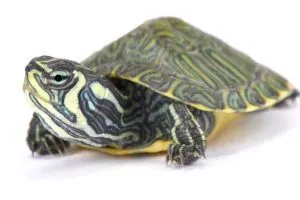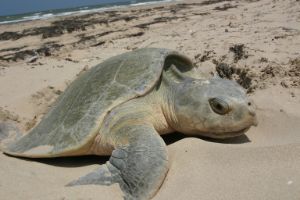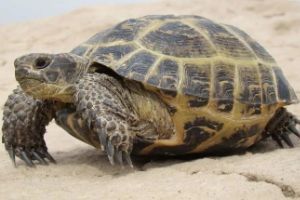how to tell what kind of tortoise you have
How to Place a Turtle
Turtles are amongst the most loved pets in the world and in that location are countless species of them from huge sea turtles to freshwater turtles and finally land turtles, also known as tortoises.
These turtles have a huge assortment of needs with different types of turtles having different needs. Turtles eat a wide variety of foods and require a wide diverseness of environmental conditions to thrive.
Identifying one turtle from some other is essential if you want to care for them. Turtle identification will assist y'all care for your turtle. You can always see a herp vet if you are still unsure.
Quick Reference Section
Types of Turtles
Outset, let's look at the types of turtles we have.
Freshwater Turtle

Nearly turtles yous would come across are freshwater turtles. Freshwater turtles are more often than not smaller as compared to other turtles. These turtles are generally aquatic or semi-aquatic and spend virtually of their fourth dimension in aquatic environments.
Apart from box turtles, which spend less time in the h2o, all other freshwater turtles spend most of their fourth dimension in h2o. Some such as the Japanese pond turtle can spend months at the bottom of a pond or stream.
Examples include snapping turtles, cooters, softshell turtles, sliders, box turtles, wood turtles, and map turtles.
Sea Turtles

These tin be establish in the ocean. They are generally big turtles and are generally purely aquatic. They exercise come to shore to lay eggs. The virtually telling feature of this type of turtle is its flippers. Instead of feet, body of water turtles take flippers.
Examples include leatherback body of water turtles, hawksbill sea turtles, and Atlantic ridley sea turtles.
Land Tortoise

These are exclusively found on state. They take high domes, and their shells are mostly heavier and less streamlined. Identify a tortoise by inspecting the feet. They accept short, elephantine legs. When land tortoises move, they walk on their toes.
Examples include Greek tortoises, Russian tortoises, Indian Star tortoises, and cherry-red-footed tortoises.
Follow These Steps to Place a Turtle
If you have pet turtles, knowing how to place a turtle is a must. To best place the turtle species, strictly follow the steps.
i. Identify If The Turtle Is A Freshwater Turtle, A Tortoise Or A Ocean Turtle.
- If the forepart limbs are flippers, then this is a bounding main turtle. They are big and rare to come beyond as they spend most of their lives in the sea. (Move to section 15, which is a section on identifying bounding main turtles.)
- If the front limbs are non flippers only instead toes (exist it webbed or non), then the turtle is either a tortoise or a freshwater tortoise. (Move on to the next section.)
- Tortoises walk on their toes while turtles walk on the flat of their feet. Turtles have flat feet while tortoises have elephant-similar clawed anxiety.
two. Inspect The Plastron Shape
- If the turtle has a plastron which covers most of its underside, and a short tail which isn't saw-similar so it isn't a snapping turtle. (Move on to the next section to better place it.)
- The common snapping turtle (Chelydra serpentina) has a pocket-size cross-shaped plastron which covers just a tiny part of the underside. This plastron is nearly half of the crush. The snapping turtle is quite large turtles with carapace lengths of 8 to eighteen.5 inches. The snapping turtle as well has a long saw-similar tail.
3. Inspect The Shell
- If the beat out/carapace is pliable and soft and the snout is elongated, and then it is a softshell turtle.
- If the trounce is hard, so it is non a softshell turtle. Motility on to the side by side section.
4. Inspect The Scutes On The Beat
Scutes cover the turtle'due south shell. They are composed of keratin.
- If the turtle has 12 scutes, proceed to department half-dozen.
- If the turtle has 11 scutes, proceed to department 5.
5. Inspect The Pectoral Scute On The Plastron
- If the pectoral scute is squarish, and there is visible pare betwixt the scutes, then it is a musk turtle.
- If the pectoral scute is triangular, and there is no visible pare between the scutes, then this is a mud turtle.
vi. Inspect The Feet
- If the toes are webbed, and the plastron isn't hinged, refer to the side by side department.
- The eastern box turtle has 12 scutes and elephant-like feet. The toes are not webbed and the plastron is hinged assuasive the turtle to exist completely enclosed in its beat. The scientific name of the eastern box turtle is Terrapene carolina carolina. Although, they are pond turtles, don't spend equally much time in water every bit compared to other freshwater turtles.
vii. Inspect The Keel
- If the carapace of the turtle is not sculptured with a central keel consisting of a pyramidal design of grooves and ridges, then refer to the side by side section. Likewise, inspect the tail of the turtle if information technology'due south a hatchling. If its tail is shorter than the carapace, definitely motion on to the next section.
- The woods turtle (Glyptemys insculpta) has a carapace that is flat and sculptured, its central ridge or keel is composed of a pyramidal pattern of grooves and ridges. The coloration of this turtle'southward plastron is yellow with blackness spots on the corners of the scutes underneath the turtle. The tail of the hatchling is equally long as its carapace.
viii. Audit The Length Of The Cervix.
- If the caput and neck tin can stretch to be as long every bit or even longer than the plastron then you have a chicken turtle (Deirochelys reticularia).
- If the stretched length of the neck and caput is less than the length of the plastron, then information technology's not a chicken turtle.
9. Inspect The Carapace
- If the carapace has concentric grooves and brownish concentric circles on the scutes, and so it may be a terrapin, also known as the diamondback terrapin (Malaclemys terrapin). This species also have several black spots on the soft grayish skin of the head, neck, and legs.
- b. If the carapace features mentioned in (a) are not available and the kegs are stripped or without marks, refer to the next section.
10. Inspect The Carapace Over again
- If the carapace has a serrated edge and saw-like vertebral keel information technology may merely be a map turtle (Graptemys spp). The red-eared slider also has serrated edges. Move on to section 13 to acquire more than.
- If the carapace is smooth rather than serrated, then it may be an Eastern Painted Turtle (Chrysemys picta picta), Spotted Turtle (Clemmys guttata), or a Bog Turtle (Glyptemys muhlenbergii). Motility on to section eleven.
11. Inspect The Jaws
- If the jaw features mentioned are absent and the carapace has spots instead refer to department 12.
- The eastern painted turtle has an upper jaw that is notched with small cusps on either side. Similarly, you lot volition discover reddish-orange lines that become across the carapace.
12. Inspect The Carapace Once Once again
- If the turtle lacks a keel, has an orange patch underneath the centre, and has a black carapace with yellowish or white spots and so information technology may be a spotted turtle (Clemmys guttata).
- If the carapace has a keel and is brown without markings, this turtle may exist a bog turtle. The bog turtle too has a carmine-orangish spot pm the neck and head.
thirteen. Audit The Head And Neck
- If the stripes on the neck are fewer than xvi, then it may be a slider or cooter. At that place are several sliders including the Cumberland slider, the Yellowish-bellied Slider, and the red-eared slider. Move to the adjacent department to narrow downwardly the type of cooter or slider you have.
- Map turtles (Graptemys spp) have stripes (over xv) on their head and neck as well every bit a small yellow patch backside their eyes. They also accept lines on their carapace which resemble contours thus the proper name Map turtle.
Identifying Sliders And Cooters
Sliders take a midpoint notch in the marginal scutes at the posterior.
Sliders
Cumberland Sliders

The Cumberland slider has an olive-green to dark-brown carapace with yellow markings.
Xanthous Bellied Sliders

The yellow-bellied slider has a solid yellow plastron. Thus the name yellow-bellied.
Red-eared Sliders

Red-eared sliders have a red patch behind their eyes. This looks like a red ear.
Cooters
The neck and caput of cooters characteristic xanthous-white stripes and the marginal scutes of the posterior aren't notched midpoint.
Northern Red-Bellied Cooter

The northern reddish-bellied cooter (Pseudemys rubriventris) has a cherry (or reddish-orange) plastron. The edges of the plastron are usually redder forming a cherry-red margin effectually the plastron. The carapace is brown or blackness with traversal yellow and orange stripes.
Eastern River Cooter

The eastern river cooter (Pseudemys concinna concinna) has a greenish-dark-brown with a 'c' mark that faces the posterior. It also has about 11 or more than stripes on the head and necks. The plastron is reddish-orange to yellow with dark lines between the scutes that fade with age.
Coastal Plain Cooter

The coastal plain cooter (Pseudemys concinna floridana) has x or fewer stripes on the caput and neck. The plastron of this species is xanthous and lacks any patterns.
Identifying Sea Turtles
Leatherback Sea Turtle

If the body of water turtle has no scutes, and then it is a leatherback sea turtle (Dermochelys coriacea).
Kemp's Ridley Sea Turtle

If the bounding main turtle has five pleural scutes and a squarish first vertebral scute with pores in its bridge scutes and iv or five inframarginal scutes, information technology is the Atlantic ridley sea turtle (Lepidochelys kempii).
Green Sea Turtle

If the body of water turtle has 4 pleural scutes and a triangular first vertebral scute with one pair of prefrontal scales on its head then it is the endangered black/green sea turtle (Chelonia mydas).
Hawksbill Sea Turtle

If the bounding main turtle has four pleural scutes and a triangular first vertebral scute with ii pairs of prefrontal scales on its head then it is the critically endangered hawksbill body of water turtle (Eretmochelys imbricata).
Loggerhead Ocean Turtle

If the body of water turtle has v pleural scutes and a squarish first vertebral scute with a big ovoid plate on its dorsum, and 4 or three inframarginal scutes on it bridge, and then its a loggerhead body of water turtle(Caretta caretta).
Identifying Country Tortoises
Land tortoises unlike their aquatic cousins (turtles) prefer to dwell on land. Unlike turtles, tortoises aren't adapted to living in h2o. They are poor swimmers and have heavier shells.
Besides, their feet are short and sturdy instead of webbed like most freshwater turtles. All of these characteristics make them better suited for the land.
There are several tortoise species in the globe. Currently, at that place are about 50 tortoise species alive. Hopefully, the number doesn't fall in the coming decades and even centuries. With and then many tortoises alive, we can't embrace them all. Nosotros will exist covering the most popular species.
Identifying A Spurred Tortoise And A Greek Tortoise

These tortoises take pointed scutes on their carapaces. These look like spurs. They are about 3 ft long and have brownish shells. Equally you lot tin see, spurred tortoises are large. In the wild, they are endemic to Sub Saharan Africa.

Greek tortoises (Testudo graeca) also accept pointed scutes on their carapaces. All the same, unlike the spurred tortoises, the Greek tortoises grow to be almost only 7 inches. Their trounce is also olive-dark-green instead of brown.
Identifying A Russian Tortoise

Russian tortoises are about 8 inches long. They have round shells and brown-black scutes. The lines in-between their scutes are yellowish. This contrasts with their black coloration. Sentry out for the contrasting yellow and black coloration when identifying a Russian tortoise.
Identifying A Indian Star Tortoise

Indian tortoises have a star pattern on each of their carapace scutes. Their scutes are pointed with white/xanthous lines connecting the edges of the scute to the centre. They are also about 8 inches long.
Identifying A Red-Footed Tortoise

The ruby-footed tortoise has red markings all over the feet. The ruby spots can also be found on the face up. The carapace is black with yellowish coloration. They are native to South American but they are besides found all over the world as pets. They are generally 11 to 14 inches long.
Identifying A Hermann's Tortoise

The easiest style to place the Hermann's tortoise is to note the chocolate-brown and yellow coloration. They are well-nigh five to 7 inches long. Their trounce is darkly colored with yellow lines in between the scutes. There are yellow spots all over their brownish skin.
Conclusion
Turtle identification is of import. It can be a difficult job unless you know what y'all are doing. While we are unable to provide a ways to identify all 300 turtles currently living, we have provided identification methods for the most pop turtles in the world.
Before we leave you, nosotros would like to remind yous that sea turtles have flippers for limbs, freshwater turtles accept flat feet, and land tortoises accept clawed elephantine anxiety.
I promise this article helps you respond the question, 'What type of turtle do I take?' If you take any comments, kindly leave them. Thanks.
congdonancentiond.blogspot.com
Source: https://www.allturtles.com/turtle-identification/
0 Response to "how to tell what kind of tortoise you have"
Post a Comment